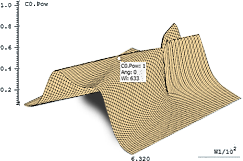MC Grating Software Usage Examples:
This page contains the descriptions for several interesting examples of MC Grating usage. You can download the corresponding structure files for the examples discussed below as well as many other examples here: Examples-Structures.zip. The document Examples-Description.pdf contains the instructions on how to perform the calculations as well as obtained results. All files with structures are adapted to limitations of the demo (unregistered) version of MC Grating. Acquaintance with examples can help user to quickly and fully master functionality of the MC Grating package.
Diffraction Mirror for Selection of CO2 Laser Radial Polarization
To select the CO2 laser radial polarization, one can use the anisotropy effect in reflection of the TE and TM polarization waves under the Littrow condition from a metal diffraction grating with triangular shape of the grooves. In the case of plane TM waves, the polarization has a higher reflection coefficient. If a diffraction grating is made on the surface of a copper cone (for example, by precision diamond turning of concentric grooves), then such a grating should select radial polarization. The contrast of radial and azimuthal polarization reflection depends on the angle at the vertex of the cone. The contrast disappears at an angle approaching 180 degrees. The calculation results can be found in section 1.1.4 of the document Examples-Description.pdf. Note: The complex value of the copper dielectric permittivity in this example is adjusted according to the limitation of the demo version, but it is very close to the tabulated copper value.
Diffraction Mirror for Synchronizing the Photodiode Array
Paper "Coherent summation of the radiation of a single-mode laser diode array" from Quantum Electronics 42(6) 561-564(2012) uses a waveguide diffraction structure with resonant abnormal reflection as the external feedback mirror for the semiconductor diode linear array. The parameters of the grating mirror were chosen in such a way that diffractive waves of the opposite direction would get excited by a waveguide under normal incidence of light on the structure. In this case, 100% light reflection is observed at the resonance wavelength (in the absence of losses of scattering and absorption in the structure). An additional condition to the waveguide planar structure is its antireflective behavior outside the resonance. Thereby, the design of the resonance mirror is divided into two stages. The first step is to calculate the antireflection waveguide structure on the selected substrate. Then, the grating period and its depth are calculated to obtain a resonance of the desired angular width at the desired wavelength. Properties of the resonant mirror prototype were adapted for the demo version: quartz and Ta2O5 were replaced by media with refractive indices 1.5 and 2.0, respectively. Section 1.1.5 of the document Examples-Description.pdf contains corresponding results and calculations.
Multilayer Mirror of a Complex Spectral Dependence
In the paper "Short-wavelength (λ = 914 nm) micro laser operating on an Nd3+: YVO4 crystal" from Quantum Electronics 30(1) 13-14(2000), the rear mirror of the laser should be transparent at a pump wavelength of 808 nm and have a reflection coefficient close to unity at a wavelength of 914 nm. To calculate such a mirror, we used the optimization feature of the MC Grating program in the absence of grating to choose the proper layer thicknesses for the multilayer structure. Results of the model calculation (adapted for the demo version – medium of low and high refractive index replaced by media with refractive indices of 1.5 and 2.0, respectively) can be found in the section 4.2 of the document Examples-Description.pdf.
Influence of Filling Factor of a Hexagonal Grating on Diffraction Efficiency
A limited set of standard scan options is built into the programs. However, sometimes you may need to scan some other parameter. Advanced scanning option can be used to enable the user to choose what type of scan is required. In this example, scanning of the filling factor value for round cylinders in a hexagonal grating is used. It turned out that the diffraction efficiency does not depend on the polarization of the incident radiation (normal incidence) with a cylinder diameter equal to half the distance between them (the default parameter embedded in the code). Under normal incidence of radiation, the total diffraction efficiency over all diffraction orders is independent of the polarization over the entire range of the filling factor. Calculation results are provided in the Section 6.4 of the document Examples-Description.pdf.
MC Grating Software is a solution of the diffraction grating analysis and design problems for multilayer periodic 1D and 2D grating structures:
- Multilayer grating filters and mirrors.
- Integrated optics grating couplers.
- Biochemistry sensing chips.
- Wire grid polarizes.
- General multilayer structures.
